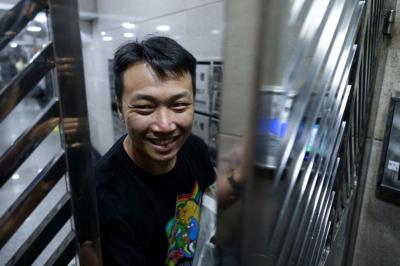The aroma of one of South Korea’s most popular delicacies is regularly compared to rotting garbage and filthy bathrooms, and that is by its fans.
The unusual dish is typically made by taking dozens of fresh skate, a cartilage-rich fish that looks like a stingray, stacking them up in a walk-in refrigerator and waiting — up to a month in some cases.
“You know when it’s done by the smell,” said Kang Han-joo, co-owner of a seafood store in the bustling fish market of Mokpo, a port city on the southwestern tip of the Korean Peninsula, a region that is considered the food’s spiritual home.
As Kang spoke, he sliced small, stinking, glistening dark-pink fish steaks with a large knife and laid them in plastic foam boxes for shipment to customers around South Korea.
The smell of the fish, called hongeo in Korean and usually eaten uncooked, is unmistakable, unavoidable and a deal-breaker for many. A profound, pungent stink of ammonia radiates from the animal after it has been ripening for weeks.
First-timers often squeeze their eyes shut as they chew. Tears stream down the cheeks. The throat constricts with the effort of swallowing.
“When it’s fermented a long time, the smell becomes deeper,” Kang said in a dramatic understatement.
Americans are still getting used to gentler fermented Asian foods — Korean kimchi and Japanese miso, for example — yet many South Koreans claim a love, an addiction even, for this extreme form of fermentation.
Restaurants specializing in the fish can be found throughout the country. One online hongeo appreciation society boasts more than 1,300 members.
“Some people start to crave it as soon as they smell the ammonia... There’s no need to advertise how intense the smell is. Everyone already knows,” said Shin Jin-woo, a seafood store worker in Mokpo.
Shin’s store has two fermentation refrigerators. Walk into one and a blast of ammonia burns the eyes, the nose and sinuses, the tongue, throat and lungs.
Skate are fermented up to 15 days in the first refrigerator, where the temperature is 2.5?C and up to another 15 days in the second at 1?C. Shops in Mokpo custom-ferment the fish and ship the results to restaurants and hongeo fans around South Korea.
The vast majority of the more than 11,000 tonnes of hongeo consumed in the country comes not from South Korean-caught fish, but from cheaper frozen imports. Shop owners thaw and clean the imported fish, which can cost up to five times less than the local version, and place the hongeo in refrigerators to ferment.
Hongeo’s history is murky, but it emerged in the days before refrigeration, when food that could keep for a long time without rotting was prized. Someone — maybe a fisherman on a long voyage or a clever, hungry or desperate farmer — discovered that skate did not spoil as easily as other fish and a dish was born.
Shop owners say the traditional method of making hongeo is to put the fish on a bed of hay in a clay pot, pile more hay on top and leave it.
Learning to love, or at least tolerate, what many consider the smelliest fish in Asia takes perseverance. Fans commonly say that if you try it four times, you will be hooked. Non-fans may be mystified by how anyone could meet that threshold.
“It’s a freaking punch in the face... Like everyone else, I gagged the first time,” said Joe McPherson, the founder of ZenKimchi, a Korean food blog, and an eventual devotee of the fish.
Natives of the southwest say hongeo should be eaten plain. They sometimes complain that the copious garnishes provided at restaurants disguise the taste and smell. Most first-timers, however, tend to embrace all the extras they can, creating a hongeo “sandwich” with garnishes that can include red pepper paste, salty mini shrimp, raw garlic, chili salt, slices of fatty boiled pork and some extraordinarily strong kimchi.
“[Even with] some of the most powerful flavors in the world to put up against it... It does not cover up the flavor at all,” McPherson said.
The extremely chewy texture — spongy flesh and hard cartilage — also makes for tough swallowing, and the smell of ammonia is so powerful it lingers for hours on clothes, skin and hair.
The second time, if there is one, is usually a little better.
One trick is to inhale through the mouth and exhale through the nose while eating. This helps fight the smell a little and also intensifies a surprising tingling and cooling — almost minty — sensation in the mouth, throat and face.
There are various theories explaining the food’s popularity. Some Koreans describe their craving as similar to the desire for a cigarette: You want it despite its obvious negatives.
McPherson says the fish is also valued for its interesting texture and the sensation it produces in the mouth — two things that can be as important to South Koreans as flavor.
There is also something convivial about hongeo restaurants, where large amounts of strong South Korean booze are as ubiquitous as the fish.

Four people jailed in the landmark Hong Kong national security trial of "47 democrats" accused of conspiracy to commit subversion were freed today after more than four years behind bars, the second group to be released in a month. Among those freed was long-time political and LGBTQ activist Jimmy Sham (岑子杰), who also led one of Hong Kong’s largest pro-democracy groups, the Civil Human Rights Front, which disbanded in 2021. "Let me spend some time with my family," Sham said after arriving at his home in the Kowloon district of Jordan. "I don’t know how to plan ahead because, to me, it feels

Polish presidential candidates offered different visions of Poland and its relations with Ukraine in a televised debate ahead of next week’s run-off, which remains on a knife-edge. During a head-to-head debate lasting two hours, centrist Warsaw Mayor Rafal Trzaskowski, from Polish Prime Minister Donald Tusk’s governing pro-European coalition, faced the Eurosceptic historian Karol Nawrocki, backed by the right-wing populist Law and Justice party (PiS). The two candidates, who qualified for the second round after coming in the top two places in the first vote on Sunday last week, clashed over Poland’s relations with Ukraine, EU policy and the track records of their

‘A THREAT’: Guyanese President Irfan Ali called on Venezuela to follow international court rulings over the region, whose border Guyana says was ratified back in 1899 Misael Zapara said he would vote in Venezuela’s first elections yesterday for the territory of Essequibo, despite living more than 100km away from the oil-rich Guyana-administered region. Both countries lay claim to Essequibo, which makes up two-thirds of Guyana’s territory and is home to 125,000 of its 800,000 citizens. Guyana has administered the region for decades. The centuries-old dispute has intensified since ExxonMobil discovered massive offshore oil deposits a decade ago, giving Guyana the largest crude oil reserves per capita in the world. Venezuela would elect a governor, eight National Assembly deputies and regional councilors in a newly created constituency for the 160,000

North Korea has detained another official over last week’s failed launch of a warship, which damaged the naval destroyer, state media reported yesterday. Pyongyang announced “a serious accident” at Wednesday last week’s launch ceremony, which crushed sections of the bottom of the new destroyer. North Korean leader Kim Jong-un called the mishap a “criminal act caused by absolute carelessness.” Ri Hyong-son, vice department director of the Munitions Industry Department of the Party Central Committee, was summoned and detained on Sunday, the Korean Central News Agency (KCNA) reported. He was “greatly responsible for the occurrence of the serious accident,” it said. Ri is the fourth person